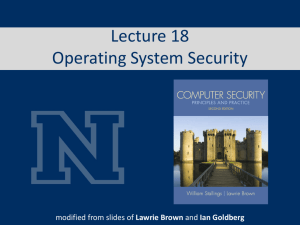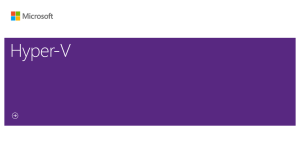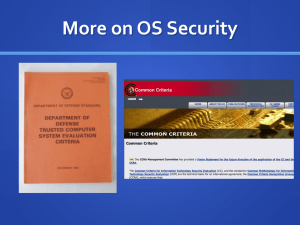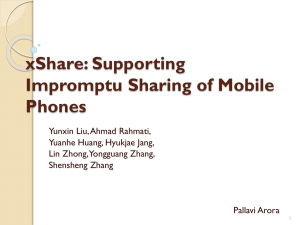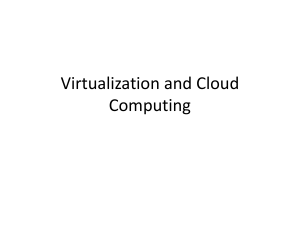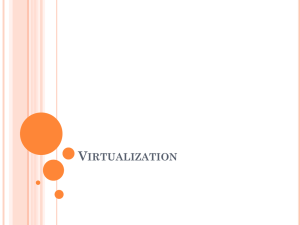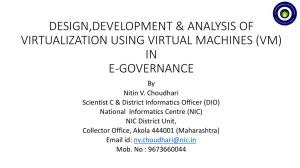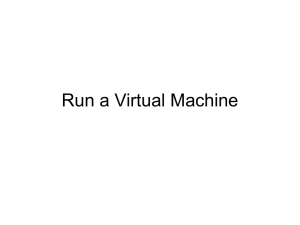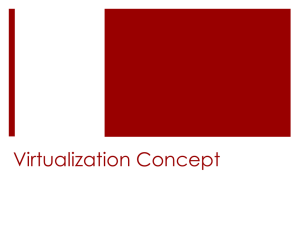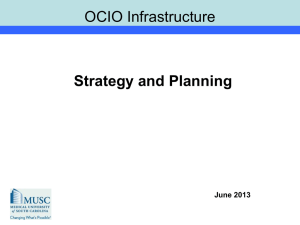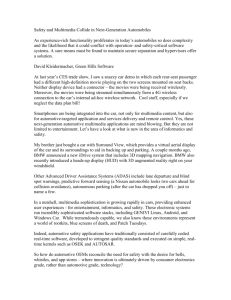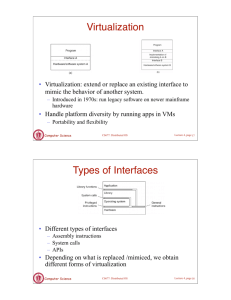ch12
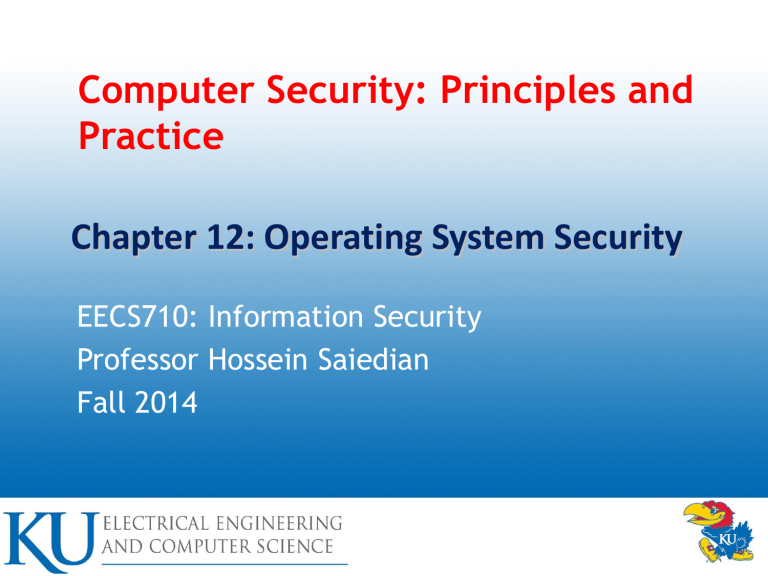
Computer Security: Principles and
Practice
Chapter 12: Operating System Security
EECS710: Information Security
Professor Hossein Saiedian
Fall 2014
OS Security Layers
Each layer is vulnerable to attack from below if the lower layers are not secured appropriately
2
OS Hardening Measures
•
•
•
The 2010 Australian Defense Signals Directorate
(DSD) list the “Top 35 Mitigation Strategies”
Over 70% of the targeted cyber intrusions investigated by DSD in 2009 could have been prevented the top four measures
The top four measures for prevention are:
– white-list approved applications
–
–
– patch third-party applications and OS vulnerabilities restrict admin privileges to users who need them create a defense-in-depth
3
Operating System Security
•
•
•
Possible for a system to be compromised during the installation process before it can install the latest patches
Building and deploying a system should be a planned process designed to counter this threat
Process must:
–
–
–
–
– assess risks and plan the system deployment secure the underlying operating system and then the key applications ensure any critical content is secured ensure appropriate network protection mechanisms are used ensure appropriate processes are used to maintain security
4
System Security Planning
•
•
The first step in deploying a new system is planning
–
–
Plan needs to identify appropriate personnel and training to install and manage the system
Planning process needs to determine security requirements for the system, applications, data, and users
Aim: maximize security while minimizing costs
5
System Security Planning Process
The purpose of the system, the type of information stored, the applications and services provided, and their security requirements
Who will administer the system, and how they will manage the system (via local or remote access)
Additional security
(firewalls, anti-virus or other malware protection mechanisms, and logging, …)
The categories of users of the system, the privileges they have, and the types of information they can access
What access the system has to information stored on other hosts, such as file or database servers, and how this is managed
How the users are authenticated
Who will administer the system
6
Operating Systems Hardening
•
•
First critical step in securing a system is to secure the base operating system
Basic steps
– Install and patch the operating system
–
–
–
Harden and configure the operating system to adequately address the identified security needs of the system
Install and configure additional security controls, such as anti-virus, host-based firewalls, and intrusion detection system (IDS)
Test the security of the basic operating system to ensure that the steps taken adequately address its security needs
7
Initial Setup and Patching
Initial installation should install the minimum necessary for the desired system
Overall boot process must also be secured
System security begins with the installation of the operating system
Ideally new systems should be constructed on a protected network
Full installation and hardening process should occur before the system is deployed to its intended location
The integrity and source of any additional device driver code must be carefully validated
Should stage and validate all patches on the test systems before deploying them in production it is critical that the system be kept up to date, with all critical security related patches installed
8
Remove Unnecessary Services
•
• if fewer software packages are available to run the risk is reduced system planning process should identify what is actually required for a given system
• when performing the initial installation the supplied defaults should not be used
– default configuration is set to maximize ease of use and functionality rather than security
– if additional packages are needed later they can be installed when they are required
Configure Users and Privileges
•
•
Not all users with access to a system will have the same access to all data and resources on that system
Elevated privileges should be restricted to only those users that require them, and then only when they are needed to perform a task
•
•
System planning process should consider:
–
–
– categories of users on the system privileges they have types of information they can access
Default accounts included as part of the system installation should be secured
–
– those that are not required should be either removed or disabled policies that apply to authentication credentials configured
Configure Resource Controls
•
•
Once the users and groups are defined, appropriate permissions can be set on data and resources
•
Many of the security hardening guides provide lists of recommended changes to the default access configuration
Further security possible by installing and configuring additional security tools:
–
–
–
–
Anti-virus software
Host-based firewalls
IDS or IPS software
Application white-listing
11
System Testing
•
Final step in the process of initially securing the base operating system is security testing
–
Goal: Ensure the previous security configuration steps are correctly implemented
•
Checklists are included in security hardening guides
•
There are programs specifically designed to:
–
Review a system to ensure that a system meets the basic security requirements
–
Scan for known vulnerabilities and poor configuration practices
12
Application Configuration
•
•
•
May include:
–
–
Creating and specifying appropriate data storage areas for application
Making appropriate changes to the application or service default configuration details
Some applications or services may include:
– Default data, scripts, user accounts
Of particular concern with remotely accessed services such as Web and file transfer services
– Risk from this form of attack is reduced by ensuring that most of the files can only be read, but not written, by the server
13
Encryption Technology
A key enabling technology that may be used to secure data both in transit and when stored
Must be configured and appropriate cryptographi c keys created, signed, and secured
If secure network services are provided using
TLS or IPsec suitable public and private keys must be generated for each of them
If secure network services are provided using SSH, appropriate server and client keys must be created
Cryptograp hic file systems are another use of encryption
14
Security Maintenance
•
•
Process of maintaining security is continuous
Security maintenance includes:
–
–
–
–
–
Monitoring and analyzing logging information
Performing regular backups
Recovering from security compromises
Regularly testing system security
Using appropriate software maintenance processes to patch and update all critical software, and to monitor and revise configuration as needed
15
Logging
16
Data Backup and Archive
Performing regular backups of data is a critical control that assists with maintaining the integrity of the system and user data
Backup Archive
The process of retaining copies of data over extended periods of time in order to meet legal and operational requirements to access past data
Needs and policy relating to backup and archive should be determined during the system planning stage
Kept online or offline
Stored locally or transported to a remote site
• Trade-offs include ease of implementation and cost versus greater security and robustness against different threats
17
Linux/Unix Security: Patch/Configs
• Patch management
–
–
–
–
–
– keeping security patches up to date is a widely recognized and critical control for maintaining security application and service configuration most commonly implemented using separate text files for each application and service generally located either in the /etc directory or in the installation tree for a specific application individual user configurations that can override the system defaults are located in hidden “dot” files in each user’s home directory most important changes needed to improve system security are to disable services and applications that are not required
18
Linux/Unix Security
• Users, groups, and permissions
– access is specified as granting read, write, and execute permissions to each of owner, group, and others for each resource
–
–
– guides recommend changing the access permissions for critical directories and files local exploit
• software vulnerability that can be exploited by an attacker to gain elevated privileges remote exploit
• software vulnerability in a network server that could be triggered by a remote attacker
19
Linux/Unix Security
• Chroot jail
–
–
–
– restricts the server’s view of the file system to just a specified portion uses chroot system call to confine a process by mapping the root of the filesystem to some other directory file directories outside the chroot jail aren’t visible or reachable main disadvantage is added complexity
20
Windows Security
Patch management
• “Windows Update” and “Windows Server
Update Service” assist with regular maintenance and should be used
• third party applications also provide automatic update support
Users administration and access controls
• systems implement discretionary access controls resources
• Vista and later systems include mandatory integrity controls
• objects are labeled as being of low, medium, high, or system integrity level
• system ensures the subject’s integrity is equal or higher than the object’s level
• implements a form of the
Biba Integrity model
21
Windows Security
Much of the configuration information is centralized in the Registry
• Forms a database of keys and values that may be queried and interpreted by applications
• Registry keys can be directly modified using the “Registry Editor”
• more useful for making bulk changes
22
Windows Security
–
–
–
–
–
–
–
–
–
Other security controls
Essential that anti-virus, anti-spyware, personal firewall, and other malware and attack detection and handling software packages are installed and configured
Current generation Windows systems include basic firewall and malware countermeasure capabilities
Important to ensure the set of products in use are compatible
Windows systems also support a range of cryptographic functions:
Encrypting files and directories using the Encrypting File
System (EFS)
Full-disk encryption with AES using BitLocker
“Microsoft Baseline Security Analyzer”
Free, easy to use tool that checks for compliance with
Microsoft’s security recommendations
23
Virtualization
•
•
•
•
A technology that provides an abstraction of the resources used by some software which runs in a simulated environment called a virtual machine (VM)
Benefits include better efficiency in the use of the physical system resources
Provides support for multiple distinct operating systems and associated applications on one physical system
Raises additional security concerns
24
Virtualization Alternatives
Application virtualization (e.g., JVM) full virtualization (e.g., multiple guest OS) allows applications written for one environment to execute on some other operating system multiple full operating system instances execute in parallel virtual machine monitor (VMM) coordinates RAM, processor, … uses hypervisor coordinates access between each of the guests and the actual physical hardware resources
25
Full Virtualization Variations
•
•
• Native virtualization: the hypervisor executes directly on the underlying hardware
Hosted OS is just another app
More secure: fewer layers
26
Full Virtualization Variations
•
•
Hosted virtualization: Hosted OS run along other apps
Adds additional layers: increased security concerns
27
Virtualization Security Issues
• Security concerns include:
–
–
–
Guest OS isolation: ensuring that programs executing within a guest OS may only access and use the resources allocated to it
Guest OS monitoring by the hypervisor: has privileged access to the programs and data in each guest OS and must be trust
Virtualized environment security: particularly image and snapshot management which attackers may attempt to view or modify
28
Hypervisor Security
•
•
•
Should be
–
–
–
–
– secured using a process similar to securing an operating system installed in an isolated environment configured so that it is updated automatically monitored for any signs of compromise accessed only by authorized administration
May support both local and remote administration so must be configured appropriately
Remote administration access should be considered and secured in the design of any network firewall and IDS capability in use
29
Summary
•
•
•
System security planning operating systems hardening
–
–
–
– initial setup and patching remove unnecessary services configure users and groups test system security
Application security
–
–
–
–
– application configuration encryption technology security maintenance data backup virtualization security
• virtualization alternatives
•
•
Linux/Unix security
–
–
–
–
– patch management application configuration users, groups, permissions remote access security testing
Windows security
–
–
–
– patch management users administration and access controls application and service configuration security testing
30
